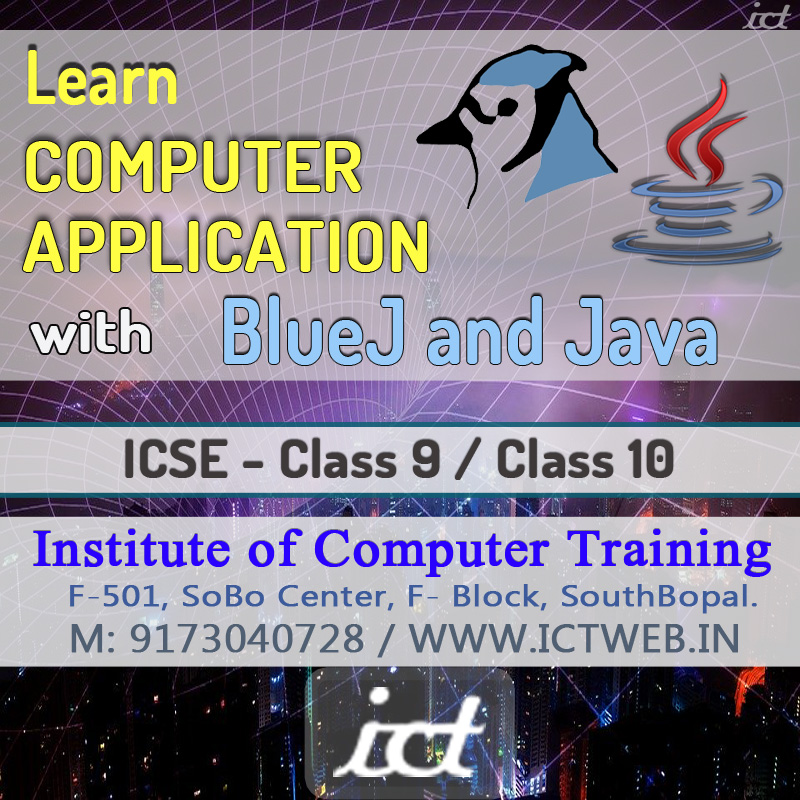
ICSE Computer Applications Class 10 Syllabus
1. Revision of Class IX Syllabus
(i) Elementary Concept of Objects and Classes.
(ii) Values and types.
(iii) Conditionals and non-nested loops.
2. Class as the Basis of all Computation
Objects and Classes
Objects encapsulate state and behaviour – numerous examples; member variables; attributes or features. Variables define state; member functions; Operations/methods/ messages/ functions define behaviour.
Classes as abstractions for sets of objects; class as an object factory; concept of type, primitive data types, composite data types. Variable declarations for both types; difference between the two types. Objects as instances of a class.
Consider real life examples for explaining the concept of class and object.
3. Constructors
Constructor and its types.
Default constructor, parameterized constructor, constructor with default parameter and constructor overloading.
4. Functions
Functions and its types
Need of functions. Types of functions (pure and impure). Function declaration and definition, ways of calling functions (call by value and call by reference) Returning information/messages from the functions and use of multiple functions and more than one function with the same name (function overloading). Use of static data member with static member function. Discuss invocation of functions on objects (through the reference). Discuss the concept of this with a reference to the object on which the invocation is made again.
5. Class as a User Defined Type
Class as a composite type, distinction between primitive type and composite or class types.
Class may be considered as a new data type created by the user, that has its own functionality.
The distinction between primitive and composite types should be discussed through examples. Show how classes allow user defined types in programs. All primitive types have corresponding class wrappers.
The following methods are to be covered:
int parseInt(String s), int valueOf(String s), long parseLong(String s), long valueOf(String s), float parseFloat(String s), float valueOf(String s), double parseDouble(String s), double valueOf(String s), boolean isDigit(char ch), boolean isLetter(char ch), boolean isLetterOrDigit(char ch), boolean isLowerCase(char ch), boolean isUpperCase(char ch), boolean isWhitespace(char ch), char to LowerCase (char ch), char to UpperCase(char ch)
6. Iterations
Loops, nested loops, break and continue.
Revision of loops (while, do while and for). Show how each kind of loop can be converted to the other form of the loop. Introduce nested loops through some simple examples. Demonstrate break and continue statements with the help of loops/nested loops.
7. Using Library Classes
Simple input/output. String, packages and import statements.
Browsing the documentation for classes in the libraries and illustrating their use. The following functions have to be covered:
String library functions:
- Char charAt (int n)
- int compareTo(String1, String2)
- String concat(String str)
- boolean endsWith(String str)
- boolean equals(String str)
- boolean equalsIgnoreCase(String str)
- int indexOf(char ch)
- int lastIndexOf(char ch)
- int length( )
- String replace (char oldChar,char newChar)
- boolean startsWith(String str)
- String substring(int beginIndex, int endIndex)
- String toLowerCase( )
- String toUpperCase( )
- String trim( )
- String valueOf(all types)
Mathematical Library Functions:
pow(x,y), log(x), sqrt(x), ceil(x), floor(x), rint(x), abs(a), max(a, b), min(a,b), random( ), sin(x), cos(x), tan(x).
Introduce the concept of packages and import statement (Avoid discussing the details of libraries).
8. Encapsulation
Access specifiers and scope and visibility
Access specifiers – private and public. Visibility rules for private, package and public access specifiers. Scope of variables, instance variables, argument variables, local variables.
9. Arrays
Arrays – storing, retrieving and arranging data
Arrays and their uses, sorting algorithms – selection sort and bubble sort; Search algorithms – linear search and binary search Example of a composite type. Array creation. Sorting and searching algorithms should be discussed (single dimensional array only).
10. Input/Output
Basic input/output using Scanner and Printer classes from JDK.
The Scanner class can be used for input of various types of data (e.g. int, float, char etc.) from the standard input stream.
Learn Understanding Computer Application with BlueJ / Java- ICSE with ICT.
Class 9 – Class 10
ICT offer computer subject tuition for ICSE Board with Theory and Practical Class.
We teach computer subject of all board like CBSE/ICSE/ISC/IB BOARD
Enroll Today!
ICT- Institute of Computer Training
F-501, SoBo Center, South Bopal.
M: 9173040728 // www.icweb.in
#bluej #java #icse #class9 #class10 #tuition #java #computer #classes #training #application
